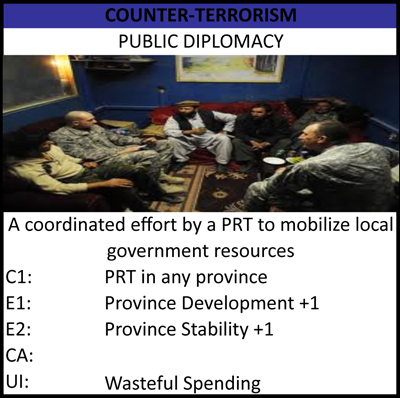 |
Keep Calm and Grog On! |
|
| Home | About Us | Article Index | Forums | Dice | GrogShop | GH ON FACEBOOK | GrogNews |
Let Your Grog Flag Fly!Recent ArticlesGARPA 17, 4/26/13 SimCity AAR Part 1, 4/25/13 Announcing MayViation, 4/24/13 Second Look at Wargame AirLand Battle, 4/21/13 First Look at Wargame AirLand Battle 4/19/13 AAR of Dark Age Minis Battle, 4/18/13 Video Review of Zulus on the Ramparts, 4/14/13 GARPA 16, 4/12/13 Crusader Kings II AAR Part 16, 4/11/13 Book Review: Ninja: 1000 Years of the Shadow Warrior, 4/10/13 Review of Bioshock INfinite, 4/7/13 Review of XFX PRO650W Core Edition PSU, 4/5/13 Civilization V AAR, Part 13, 4/4/13 Fire with Fire, 3/31/13 GARPA 15, 3/29/13 Civilization V AAR, Part 12, 3/28/13 Wheaton INterview, 3/27/13 March Mayhem Winner, 3/25/13 Warlock Multiplayer AAR, 3/21/13 WWII PTO Alternate Histories, 3/20/13 GARPA 14, 3/15/13 Crusader Kings II AAR, part 15, 3/14/13 Civilization V AAR, part 11, 3/7/13 Prezcon Convention Coverage, 3/2/13 Civilization V AAR, part 10, 3/3/13 |
The Long War, A Developer's DiaryPart Two: PoliciesBy Christopher Davis, 13 June, 2012Christoper Davis gives us the inside scoop on his development of The Long War (working title), based in large part on his personal experiences on-the-ground in Afghanistan.The Long War is a multi-layer strategy game, requiring the player to think and act on multiple lines of effort. The first, and highest, layer is the policy level. Each player, representing the USA, the Government of Afghanistan, and the Taliban, will have three policies from which to choose. The policies reflect the general approaches towards the conflict and emphasize distinct tactics. The policies also have policy leaders; high-ranking bureaucrats that more or less guide the course of the war. Policies are important because they determine which cards the player can draw. Because each card has specific activation conditions (such as the presence of a particular unit), it is important for players to tie together policy selection and force structure when mapping out their strategy.
For the United States, the policies are: Counter-Terrorism, Counter-Insurgency, and Advise-and-Assist. The counter-terrorism policy reflects the early US war effort prior to the introduction of regular army units and the expansion of ISAF. It also in some ways mirrors Vice President Biden’s proposals during the Obama administration’s strategic review of the war’s progress. It emphasizes the use of intelligence assets and special operations forces to target Taliban leadership and safe havens, while leaving the hearts and minds of the Afghan people to the Afghan government. One operational card from this policy is the “Cross-Border Raid”, which affords the US player one method in targeting Taliban safe havens in Pakistan. The second policy, Counter-Insurgency, aims to improve the legitimacy of the Afghan government by providing for the stability and development of the population. This strategy provides for an intense engagement with the local citizens. It is suitable for larger conventional forces capable of sustaining a dispersed presence. One operational card from this policy is the “Local Hiring Program,” which improves stability by tying the economic conditions of the province with the security of US forces. However, it comes with the risk of an insider threat, which exposes US forces to potential attack from infiltrators.
The last policy, Advise and Assist, represents the on-going emphasis on training Afghan security forces to be reliable combat units. This policy utilizes actions such as training and support programs that increase the capabilities of Afghan military units. One operational card from this policy is a “Commando Assistance Program” which increases the capabilities of GIRoA special operations units. As stated earlier, each policy has policy leaders. Players can select three, each representing a specific organization that is a part of the war effort. The US player may appoint the ambassador to Afghanistan, the ISAF commander, and the CIA Kabul station chief. The positions have a pool of real-world leaders from which to choose. Each policy leader has a modifier that is applied to all US units. However, each policy leader also has a policy preference. If the leader has a preference different from a chosen policy, he becomes a lame duck leader with no effect on the war. Policy leaders can be replaced but at a high political cost. This is to represent the institutional buy-in necessary to effectively implement the chosen policy. Operational leaders (those mid-level commanders and diplomats in the field) also have preferences, and their otherwise positive modifying effect on the battlefield becomes markedly negative if their preference differs from that of the selective policy. However, the preferences also enable the player to draw operational cards to which he may otherwise have access. There are always trade-offs. The series will continue with discussing operational cards, leaders, and forces in more detail.
|
Please support the folks that support GrogHeads
|
Copyright ©2012-2019, Grogheads, LLC. All rights reserved in the United States and throughout the world. All other products and copyrights mentioned on Grogheads, LLC are the property of their respective companies, and Grogheads, LLC makes no claim thereto.
GrogDice - Refresh the screen to roll a new set!
Or go here to roll a LOT of dice


